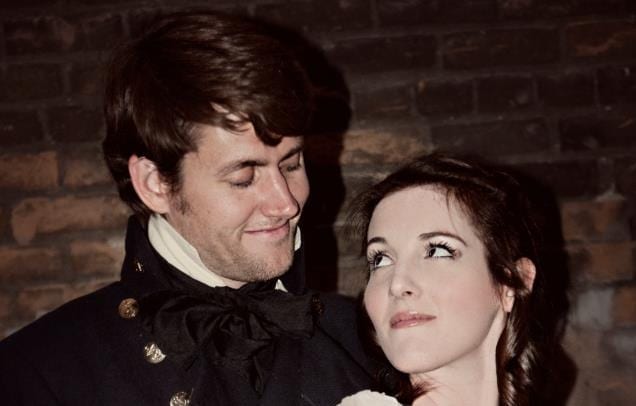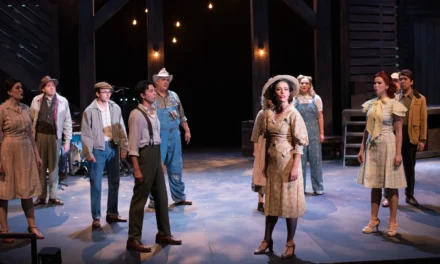OGDEN — What are the hardworking men of Buffalo to do when the factory shuts down? It isn’t just an income they’ve lost, as they have been out of work for up to eighteen months. Individual loss ranges from the abstract ideas of pride and identity to the more concrete repercussions of loss of property or an impending loss of custody, and the resulting damage isn’t always visible. As these men see their wives and ex-wives spending cold, hard cash to see the toned bodies of the Chippendales, they set a plan in motion that doesn’t stop anywhere short of The Full Monty. Relationships are strengthened and pride is restored as six friends rediscover their self-worth by baring it all.

Show closes May 19, 2018.
Intentionally presented as a story of “everyman,” the characters bear names that feel interchangeable and offer little identity in and of themselves. Jerry Lukowski (played by Jeremy R. Gross) is fighting with his ex-wife Pam (played by Becky Jeanne Knowles) over custody of their son Nathan (played by Declan McAlhany). Dave and Georgie Bukatinsky (played by real-life married couple Caleb and Morgan Parry) are struggling with the effects of having their traditional gender roles threatened. Malcolm (played by Nick Morris) struggles with survivor’s guilt as one of the few men still employed. Ethan (played by Tommy John Holt), Harold (played by Shaun Carr), and Noah “Horse” T. Simmons (played by Carlos Emjay) round out the group of men looking for an out-of-the-box solution to his individual problems.

TJ Holt as Ethan.
This musical adaptation of the 1997 film by the same title, featuring a book by Terrence McNally and score by David Yazbek, offers a fast-paced romp where even the ballads evoke fits of rolling laughter. Hugh Hanson was tasked with bringing the beautiful story (book-ended by a musical strip show) to life on the The Ziegfeld Theater stage. From my first moments in the slowly filling theater, I was transported to the setting he had selected as I listened to a string of retro radio ads hocking everything from Sudafed to hemorrhoid cream. At intermission, sound designer Kyle Lawrence continued the audio treat with the play-by-play from an old Bulls game.

Carlos Emjay as Horse.
Using technology in this way allowed Caleb Parry to present a simple set design that worked as a physical way to add a second tier for actors and as a backdrop for projections that distinguished between the different interior and exterior settings throughout the story. There were very few set pieces that needed to be moved on and off, which made for efficient transitions. However, sometimes these transitions felt jarring as the projection flicked to the next scene before I had emotionally disconnected from the current moment. One scene ended with Nathan asleep in a living room chair; as Jerry pushed both chair and cast member off the stage in the full light of the next scene’s projection, I found myself wanting the closure of a blackout.
The cast, on the other hand, left little lacking. Parry and Gross delivered the chemistry of an authentic pair of best friends, bantering and heckling in the stereotypical way of men. From the moment Emjay took the stage as Horse, I was spellbound by the intricacies of his character. From the way he walked to the way he danced to his posture in a still moment, Emjay never deviated from the character he had created. The flavorful costumes provided by the theater’s costume department added meaningful dimension especially to Horse and Jeanneatte (played by Camille Van Wagoner), whose details down to the respective cane and fanny pack add both comedy and depth.

Jeremy Gross as Jerry.
Under the musical direction of Lawrence, this cast delivered the rich harmonies demanded by the challenging score. Most impressively, these men never let their accuracy distract from a scene, even when they crooned a tight barbershop number wearing next to nothing. In some places, the solos were just outside the upper vocal range of this cast who seemed to be lacking a high tenor. This was particularly evident during the opening number, “Scrap.” Even in a cast full of outstanding vocalists, Van Wagoner’s “Jeanette’s Showbiz Number” was a highlight of my evening, and I found myself wishing the score called for a bit more.
The director’s notes acknowledge precisely the amount of knowledge I had going into this production as a patron: “I already knew it was a show about average guys stripping.” (For those who would prefer to be surprised, go ahead and skip this paragraph. ) For those who may consider letting the potential nudity stop you from seeing this hilariously profound show, I’m including the following to help you make an educated decision. I was personally grateful to the females in the cast who spent the first strip club scene hooting and hollering at Buddy “Keno” Walsh (played by Wyatt Welch), the first of the men to discard a few items on stage. Their comfort level and energy helped my personally reserved nature ease into the show. Once I settled in, I actually found that the partial nudity was not as uncomfortable for me as some of the language was. One strong theme of the show is best summed up by lyrics that beg, “tell me what my label is!” Struggling to find their own identity, characters in the show used strong, derogatory labels including “fairy” when referring to a homosexual Chippendale or to the idea of male dancers in general. The painful cringe I felt as characters used the language necessary to tell a poignant and accurate story was the hardest part of watching this show.
Then there were the moments when my own riotous laughter brought me to the edge of feeling physically ill. “Big-Ass Rock,” a song about the best way to commit suicide, was easily the funniest thing I have ever seen on stage, but the desperation in the theme is still haunting me several days later.
Finally, if you want to know exactly how much to prepare for, Joshua S. Robinson’s choreography is designed to stop just short of full nudity, with carefully positioned pieces in the important places. However, I have to mention the concluding strip scene gave me a little more than I bargained for as I tightly squeezed my slightly overwhelmed eyes shut a half a second too late, due to a costume malfunction (or a slight timing snafu). Still, I got exactly what my ticket said I had paid for: The Full Monty.
Donate to Utah Theatre Bloggers Association today and help support theatre criticism in Utah. Our staff work hard to be an independent voice in our arts community. Currently, our goal is to pay our reviewers and editors. UTBA is a non-profit organization, and your donation is fully tax deductible.




